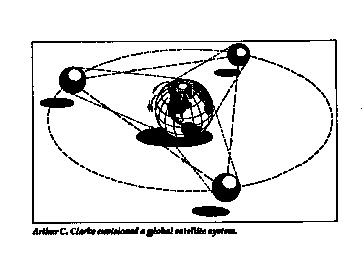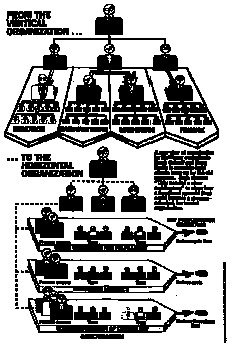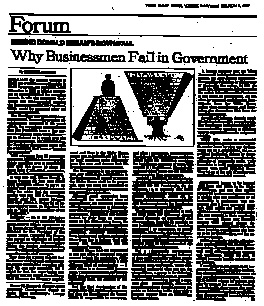PART I/No. 2 of 3: Acceptance Speech by
Dr. Takeshi Utsum
V. PHILOSOPHY OF THE GLOBAL UNIVERSITY
The underling philosophy of our Global University is condensed in the logo of GLOSAS/USA. Let me explain it.
SLIDE 2: (Click here for large diagram)
About a half century ago, Arthur C. Clarke, a recipient of Lord Perry Award two years ago, conceived the idea of global satellite communication system. Three satellites can cover the entire globe.

SLIDE 3: (Click here for large diagram)
This slide views the globe from north to south direction. The center circle is the globe. Three representative analog satellites are at the corners of an equilateral triangle which is positioned vertically in this diagram. The outer circle is the geosynchronous orbit where there are many stationary satellites nowadays.

SLIDE 4: (Click here for large diagram)
We advocate a Space Station Library System which will consist of three space stations on the geosynchronous orbit. Not only books and archived information in the U.S. Library of Congress or at any of similar libraries in any countries, but also educational courses available at any schools on earth can be uplinked to the nearby space station library to be stored in compact disks which can be retrieved with a jukebox-type system. Those space libraries and ordinary communication and broadcasting satellites will be connected via laser communication beams which technology is now a hot pursuit in Japan, the U.S. and European countries. One can obtain information or educational courses from the other side of globe through those routes. We call this system a Strategic Peace Initiative (SPI). In this slide diagram, three representative space station libraries are positioned at the corners of an equilateral triangle which is positioned as an inverse-pyramid.

SLIDE 5: (Click here for large diagram)
This slide shows only the equilateral triangle of the original analog satellite system. This vertical pyramid can be a symbol of conventional, feudalistic, militaristic, command and control hierarchy.

SLIDE 6: (Click here for large diagram)
However, many of vertically structured, functional pyramid organizations are currently being restructured to become more process-oriented, horizontally structured organizations, as shown on this slide [FORTUNE, 1992]. This fundamental movement is largely due to proliferated use of new communication media (such as fax, e-mail, etc.) that change an organization's structure and culture [BUSINESS WEEK, 1994 and Nippon Keizai Shimbun, 1989].

SLIDE 7: (Click here for large diagram)
When Mr. Donald T. Regan (former chairman of Merrill Lynch & Company) was fired from the position of the Chief of Staff of the Reagan Administration, an essay appeared in The New York Times, March 8, 1987. It was written by Mr. James M. Kouzes, Director of the Executive Development Center, Leavery School of Management of Santa Clara University, and titled "Behind Donald Regan's Downfall: Why Businessmen Fail in Government." A few of excerpts from the article are [The New York Times, 1987];

"the dominant principle of large corporations is in direct conflict with the dynamics of democratic governance.
Businesses are characterized by their focus on management as the rationalizing force, asserting influence and control over the company by using its hierarchical organization. Authority relationships must be clear and explicit, and power flows from top to bottom. Cost efficiency and effectiveness are the measures of success.
[on the other hand,] The cardinal rule in our society holds that the government derives its legitimacy from the consent of the governed. (...) Elected officials and their staffs are not masters of the people; they are servants. (...) Above all, secrecy, disinformation and autocratic rule have no place in the functioning of a representative democracy.
But a democratic government, whose success is measured in terms of just and equitable policies, needs give-and-take bargaining to work. Negotiating is a way of life. Those with opposing points of view are not the competition, a group to be defeated. Rather they must be seen as potential collaborators working toward a common goal. Furthermore, successful negotiators know that the process depends on listening to the other side's position rather than on reiterating one's own views.
In this regard, Mr. Regan again failed to make the switch from the world of business to the world of government.
(...) running a government office requires a different view of organization and a unique set of skills.
Those who make a successful transition from private sector to public sector learn to view our Government not as a corporation, but as a political institution, driven by democratic principles. They accept the legitimacy of competing view. They learn how to build consensus and negotiate with those opposing them. They let go of the role of master and cherish the role of civil servant."
SLIDE 8: (Click here for large diagram)
This slide is taken from the article. A chief executive officer of a
business organization is at the top of a vertical pyramid. The President
of a democratic government is at the bottom of an inverse pyramid, as holding
the burden of its weight up. This reminds me a famous word by President
Harry S. Truman, who said, "I would be promoted from the chief executive
of civil servants to the master of government," when he was retiring
from his presidency. The first Tokugawa Shogun in Japan also said that
life was like climbing a mountain with a heavy burden on shoulders. Christ
washed a foot of a poor woman.

Global University is an educational SERVICE organization, fostering creativity of and global citizenship among youngsters to work together harmoniously for global problems.
Back to
[ Top of this page | GLOSAS
home page | List
of Activities ]
Continue to PART I/No.3 of 3